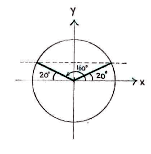Solution 4.3:9
From Förberedande kurs i matematik 1
m |
|||
| Line 1: | Line 1: | ||
| - | Using the formula for double angles on | + | Using the formula for double angles on <math>\sin 160^{\circ}</math> gives |
| - | <math>160^{\circ }</math> | + | |
| - | gives | + | |
| + | {{Displayed math||<math>\sin 160^{\circ} = 2\cos 80^{\circ}\sin 80^{\circ}\,\textrm{.}</math>}} | ||
| - | <math> | + | On the right-hand side, we see that the factor <math>\cos 80^{\circ}</math> has appeared, and if we use the formula for double angles on the second factor (<math>\sin 80^{\circ}</math>), |
| + | {{Displayed math||<math>2\cos 80^{\circ}\sin 80^{\circ} = 2\cos 80^{\circ}\cdot 2\cos 40^{\circ}\sin 40^{\circ}\,,</math>}} | ||
| - | + | we obtain a further factor <math>\cos 40^{\circ}</math>. A final application of the formula for double angles on <math>\sin 40^{\circ }</math> gives us all three cosine factors, | |
| - | + | ||
| - | + | ||
| - | + | ||
| - | + | ||
| - | + | ||
| - | + | ||
| - | + | ||
| - | + | ||
| - | + | ||
| - | we obtain a further factor | + | |
| - | <math>\cos 40^{\circ }</math>. A final application of the formula for double angles on | + | |
| - | <math>\sin 40^{\circ }</math> | + | |
| - | gives us all three cosine factors | + | |
| - | + | ||
| - | + | ||
| - | + | ||
| + | {{Displayed math||<math>2\cos 80^{\circ}\cdot 2\cos 40^{\circ}\cdot\sin 40^{\circ} = 2\cos 80^{\circ}\cdot 2\cos 40^{\circ}\cdot 2\cos 20^{\circ}\sin 20^{\circ}\,\textrm{·}</math>}} | ||
We have thus succeeded in showing that | We have thus succeeded in showing that | ||
| - | + | {{Displayed math||<math>\sin 160^{\circ} = 8\cos 80^{\circ}\cdot \cos 40^{\circ}\cdot \cos 20^{\circ}\cdot\sin 20^{\circ}</math>}} | |
| - | <math>\sin 160^{\circ }=8\cos 80^{\circ }\ | + | |
| - | + | ||
which can also be written as | which can also be written as | ||
| + | {{Displayed math||<math>\cos 80^{\circ}\cdot\cos 40^{\circ}\cdot \cos 20^{\circ} = \frac{\sin 160^{\circ}}{8\sin 20^{\circ}}\,\textrm{.}</math>}} | ||
| - | <math> | + | [[Image:4_3_9.gif||right]] |
| + | If we draw the unit circle, we see that <math>160^{\circ}</math> makes an angle of | ||
| + | <math>20^{\circ}</math> with the negative ''x''-axis, and therefore the angles | ||
| + | <math>20^{\circ}</math> and <math>160^{\circ}</math> have the same ''y''-coordinate in the unit circle, i.e. | ||
| - | + | <center><math>\sin 20^{\circ} = \sin 160^{\circ}\,\textrm{.}</math></center> | |
| - | + | ||
| - | < | + | |
| - | + | ||
| - | <math>20^{\circ } | + | |
| - | + | ||
| - | + | ||
| - | + | ||
| - | + | ||
| - | + | ||
| - | + | ||
| - | + | ||
| - | + | ||
| - | + | ||
| - | + | ||
| - | + | ||
| - | + | ||
| - | + | ||
| - | + | ||
This shows that | This shows that | ||
| - | + | <center><math>\cos 80^{\circ} \cos 40^{\circ} \cos 20^{\circ} = \frac{\sin 160^{\circ}}{8\sin 20^{\circ}} = \frac{1}{8}\,\textrm{.}</math></center> | |
| - | <math>\cos 80^{\circ } | + | |
Current revision
Using the formula for double angles on \displaystyle \sin 160^{\circ} gives
| \displaystyle \sin 160^{\circ} = 2\cos 80^{\circ}\sin 80^{\circ}\,\textrm{.} |
On the right-hand side, we see that the factor \displaystyle \cos 80^{\circ} has appeared, and if we use the formula for double angles on the second factor (\displaystyle \sin 80^{\circ}),
| \displaystyle 2\cos 80^{\circ}\sin 80^{\circ} = 2\cos 80^{\circ}\cdot 2\cos 40^{\circ}\sin 40^{\circ}\,, |
we obtain a further factor \displaystyle \cos 40^{\circ}. A final application of the formula for double angles on \displaystyle \sin 40^{\circ } gives us all three cosine factors,
| \displaystyle 2\cos 80^{\circ}\cdot 2\cos 40^{\circ}\cdot\sin 40^{\circ} = 2\cos 80^{\circ}\cdot 2\cos 40^{\circ}\cdot 2\cos 20^{\circ}\sin 20^{\circ}\,\textrm{·} |
We have thus succeeded in showing that
| \displaystyle \sin 160^{\circ} = 8\cos 80^{\circ}\cdot \cos 40^{\circ}\cdot \cos 20^{\circ}\cdot\sin 20^{\circ} |
which can also be written as
| \displaystyle \cos 80^{\circ}\cdot\cos 40^{\circ}\cdot \cos 20^{\circ} = \frac{\sin 160^{\circ}}{8\sin 20^{\circ}}\,\textrm{.} |
If we draw the unit circle, we see that \displaystyle 160^{\circ} makes an angle of \displaystyle 20^{\circ} with the negative x-axis, and therefore the angles \displaystyle 20^{\circ} and \displaystyle 160^{\circ} have the same y-coordinate in the unit circle, i.e.
This shows that

